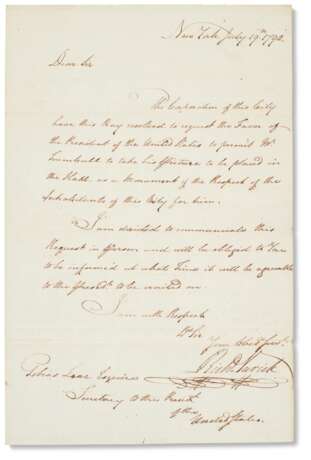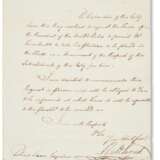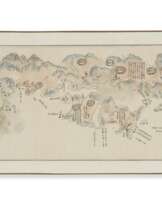ID 627680
Lot 190 | New York City commissions a painting of Washington
Valeur estimée
$ 8 000 – 10 000
One page, bifolium, 307 x 200mm with integral transmittal leaf addressed in his hand (loss to address panel from seal tear).
New York City commissions John Trumbull to paint a portrait of George Washington that now hangs at City Hall. Written in his capacity as mayor, Richard Varick, Washington's former aide-de-camp sends official notice of New York City's resolve to have a portrait of Washington: "The Corporation of this City have this Day resolved to request the Favor of the president of the United States to permit Mr. Trumbull to take his picture to be placed in the Hall as a Monument of the Respect of the Inhabitants of this City for him. I am directed to communicate this Request in person and will be obliged to You to be informed at what Time it will be agreeable to the presidn't to be waited on."
Lear, Washington's personal secretary, responded the same day in the affirmative, informing Varick that the President would be able to see him the next day at 10 am to present the city's official request (a copy of which resides in the Washington Papers at the Library of Congress). The following day, Varick asked Vice President Adams "to permit Colo. John Trumbull take his portrait to be placed in the City Hall, to which the President has consented & Mr Trumbull has suggested to me that as the portrait will be large the Room in the Hall in which those of the King and Queen of France are placed will be most eligible to perform the painting in & that he will take Care that no possible Injury or Inconvenience shall be occasioned by this Indulgence to him. The whole of the Hall being devoted to the Use of Congress, I take the Liberty of thus addressing You Sir, as well as the Speaker of the House of Representatives on the Subject & of soliciting your permission, under a persuasion that your respective Assent will be sufficient, without troubling the Senate or House” (Varick to John Adams, 21 July 1790, Adams Papers, Massachusetts Historical Society).
Washington had already sat for Trumbull (he too a former aide-de-camp) in late 1789 and early 1790, who had completed a full-length portrait of his former commander-in-chief when he learned of New York's commission. Rather than taking more of the president's valuable time in sitting, he enlarged a full-length portrait he had given to Martha Washington as a gift. Confiding to mentor Benjamin West on 30 August 1790, Trumbull wrote that he had "several small portraits of the President … one in particular which I have done for Mrs. Washington … is thought very like—& I have been tempted to disobey one of your injunctions & to attempt a large Portrait of him for this City which I am now finishing," and adding that "it is to Hang in the most elegant Room in America & in a very perfect light." (Trumbull, Autobiography). The work done for Martha Washington was entitled Washington at Verplanck's Point. In enlarging the city's version, he altered the background scene from the September 1782 review performed for the benefit of Rochambeau, to an idealized view of the British evacuation from New York in November 1783. Today, the portrait hangs in the Governor's Room at New York City Hall. For a more in-depth treatment of the history of this painting, see the extensive note for Lear's response to the present letter in The Papers of George Washington, Presidential Series, Vol. 6 (Tobias Lear to Richard Varick, 19 July 1790).
| Artiste: | William Shakespeare (1564 - 1616) |
|---|---|
| Technique appliquée: | Crayon |
| Artiste: | William Shakespeare (1564 - 1616) |
|---|---|
| Technique appliquée: | Crayon |
| Adresse de l'enchère |
CHRISTIE'S 8 King Street, St. James's SW1Y 6QT London Royaume-Uni | |
|---|---|---|
| Aperçu |
| |
| Téléphone | +44 (0)20 7839 9060 | |
| Commission | see on Website | |
| Conditions d'utilisation | Conditions d'utilisation |












